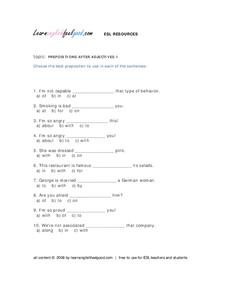Have Fun Teaching
Context Clues (5)
Unfamiliar words can make it difficult to understand what a piece of writing is trying to say. Practice using context clues to define words you don't know with a language arts learning exercise, which features five sentences and enough...
K12 Reader
Context Clues: The Meaning Is There!
Learning how to use context clues is helpful for both reading comprehension skills and to determine the meaning of unfamiliar vocabulary words. As they read ten sentences with underlined words, learners choose the most...
Prestwick House
Vocabulary Activity Sheet
What does it mean to stream a program? How do you know if you're watching a mash-up? If you don't know these words, reach for your handy Merriam-Webster dictionary, because they're there! A series of fill-in-the-blank questions prompt...
Prestwick House
Vocabulary in Context: Inside the World of Wizards
Enter the world of Harry Potter and learn new vocabulary at the same time. A high-interest reading passage provides insight into the history of Harry Potter. Follow-up activities incorporate key vocabulary strategies, such as using...
K12 Reader
Determine the Meaning
Enhance elementary readers' vocabulary skills with a worksheet focused on context clues. Individuals read ten short sentences, each with an underlined word, and look over four options to find the most appropriate synonym that could...
LearnEnglishFeelGood.com
Participles Used As Adjectives
Is a movie interesting or interested? Use context clues to decide which participle would be the most appropriate in each of ten sentences.
Teach-nology
Being a Comedian Isn’t All Laughs
What's it like to be a comedian? Find out with a short cloze passage about the life of a comedian. Kids use eight words at the bottom of the page to fill in the blanks throughout the passage.
K12 Reader
Understanding the Context: The Mayflower Compact
Scholars obtain a brief background of the Mayflower Compact, read its contents, and answer two questions that look at the passage's context to enhance reading comprehension.
Prestwick House
Vocabulary in Context: Wilderness Survival
Do you have what it takes to survive in the wilderness? A high-interest reading passage offers practical advice while incorporating vocabulary practice. Follow-up worksheets focus on skills such as defining words, making inferences, and...
LearnEnglishFeelGood.com
Simple Present or Present Continuous?
Mastering verb tense is an important part of building your learners' reading skills. Young grammarians look over ten sentences and use context clues to decide whether they should use the present or present progressive tense.
Have Fun Teaching
When Am I? (16)
How can you tell when a story takes place? Use context clues to infer the time of day and seasons of five short reading passages. Kids then note each passage's time period as daytime or nighttime, as well as winter or summer.
LearnEnglishFeelGood.com
Count or Non-Count Nouns?
Many learners struggle with the difference between count and non-count nouns. When do you use a few or a little? Or much or many? Take a look at ten sentences where young grammarians can use context clues to decide which noun fits in the...
K12 Reader
Using Collective Nouns
What do you call a group of soccer players? Or a bunch of bees? Young grammarians review eight sentences and add the correct collective noun based on the context clues they observe.
LearnEnglishFeelGood.com
Mixed Verb Tenses
He was running or he has been running? Young grammarians must examine context clues to determine which verb phrase to use in ten sentences.
LearnEnglishFeelGood.com
Choose the right preposition for each phrasal verb
Clarify the meanings of ten sentences with a fill-in-the-blank worksheet. As young grammarians study the context clues in each sentence, they choose which preposition would best complete the thought.
K12 Reader
Identifying Adverbs IV
What a mess! Read about Lilly-Ann's birthday cupcake surprise and work on grammar skills at the same time. Four lengthy paragraphs provide kids with many opportunities to find and circle adverbs. They note the ways that adverbs come in...
LearnEnglishFeelGood.com
Gerund or Infinitive?
Decide which form of the verb to use in ten sentences. Young grammarians watch for context clues when determining if they should use gerunds or infinitives in the blank spaces of each sentence.
K12 Reader
Proverbs and Adages: What’s the Meaning?
Your kids have probably heard these idioms before, but do they know what they mean? Help them learn that haste makes waste, an ill wind blows no good, and that ignorance is bliss with a list of popular expressions.
K12 Reader
Inference Practice: Where Am I?
Have your pupils try a hand at making inferences. The worksheet includes five different descriptions, and learners must infer where they think the passage is happening and provide some explanation. A straightforward resource for...
K12 Reader
Little Women: Helping Father
Jo's decision to sell her hair to bringing her wounded father home is a pivotal and poignant scene from Louisa May Alcott's Little Women. Class members read the excerpt and answer four questions about the details, vocabulary, and plot...
K12 Reader
National Symbols
What are the most prominent symbols of the United States? Learn about the bald eagle, the American flag, and the Statue of Liberty in a reading comprehension activity that includes a short passage and five reflective questions.
K12 Reader
Adventures with Alliteration! - Verbs
Work with wonderful words within a well-written learning exercise! Kids match alliterative verbs to fifteen names in order to get alliterative phrases.
K12 Reader
Inference in Literature: The Wizard of Oz
We're off to see the wizard! Practice making inferences in literature with two sample paragraphs from L. Frank Baum's The Wonderful Wizard of Oz. Each passage provides questions about the pleasantness of the place it describes, and kids...
LearnEnglishFeelGood.com
Prepositions After Adjectives
Practice reading context clues with a set of ten sentences within a grammar activity. As they examine each sentence, readers choose which preposition would be most appropriate after the adjective shown.

























